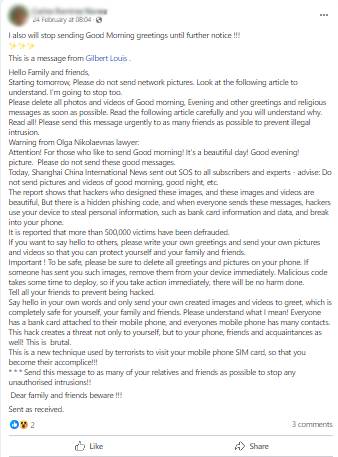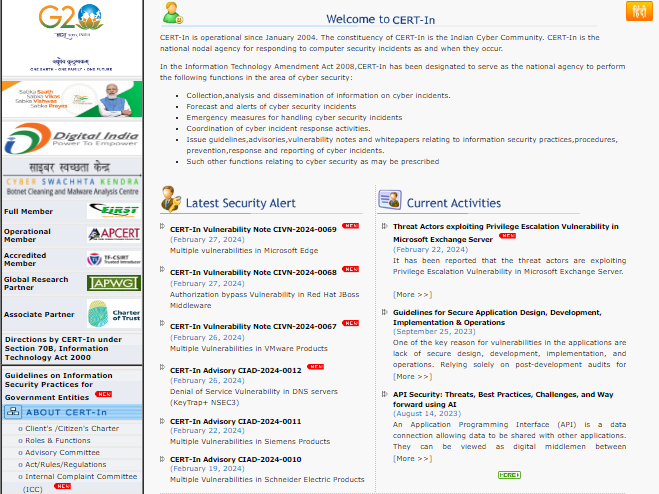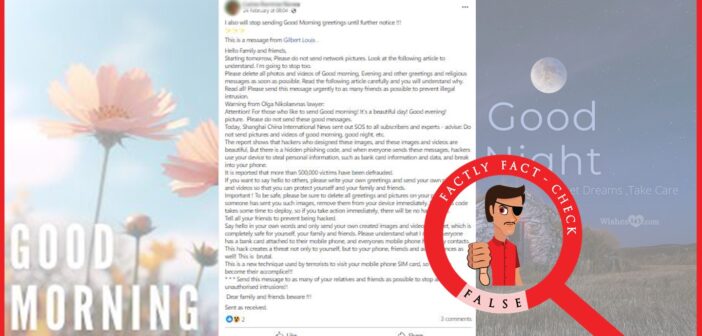A post claiming that sending ‘good morning’ or ‘good evening’ messages can hack personal information due to hidden phishing codes by hackers, is circulating widely on social media. The message further asserts that the warning has been issued by Shanghai International News attributing it to Olga Nikolaevnas. This article aims to fact-check the claim.

Claim: Hackers have concealed “phishing codes” in good morning images; receiving one could expose your private information – warning by Olga Nikolaevnas.
Fact: There are no news reports or official information from government agencies about hackers stealing private information through messages like “good morning” or “good evening.” Similar messages have been circulating on social media since 2017. Furthermore, there is no evidence of the existence of any media outlet named Shanghai International News. However, there is a risk of personal information theft through any image or message containing phishing codes. Hence, the claim made in the post is False.
The message claims to be sourced from Shanghai International News. However, there is no evidence of the existence of such a media outlet. The government has not issued any warning about hackers stealing data through messages like “good morning” or “good evening.” Indeed, if such incidents occurred, several news organizations would have published stories on this matter. However, we didn’t find any news reports regarding this.
Subsequently, we checked the website of the Indian Computer Emergency Response Team (CERT-In) and the official website of the Ministry of Electronics and Information Technology regarding the apparent threat mentioned in the viral message. However, we didn’t find any advisory notices on these websites.

Upon further research, we discovered that the process of concealing secret information within a data source is known as Steganography. In this technique, malware or phishing URLs can be hidden in text files, images, audio, and video, often escaping detection by conventional malware detection tools.
What is a Phishing attack?
Phishing attacks are the practice of sending fraudulent communications that appear to come from a reputable source. It is usually done through email. The goal is to steal sensitive data like credit cards and login information, or to install malware on the victim’s machine. Phishing is a common type of cyber-attack that everyone should learn about to protect themselves. More information about Phishing can be found here.
How to protect ourselves from cyber-attacks:
Here are some steps you can take to protect yourself from cyber-attacks.
- Malware and ransomware can be embedded in links, attachments, and downloads. Make sure a link is authentic before clicking on it.
- Create and use strong passwords. One should always use strong and long passwords that are difficult to hack. Use unique passwords, meaning a different one for each account. Passwords should be at least 8 characters in length and contain numbers, special characters, and capitalized letters.
- Use multi-factor authentication whenever possible. Multi-factor authentication adds an extra layer of security. If a service you are using offers multi-factor authentication, use it.
- Use secure internet communications. Use sites that use “HTTPS” if you will access or provide any personal information. Don’t use sites with invalid certificates.
- Make sure your anti-virus software is up to date and updates are installed regularly.
Moreover, if you accidentally download and trigger malware, it will execute immediately; it won’t wait as the hoax message claims. Deleting “good morning” or “good night” photos or videos will free up storage space on your phone, but it won’t prevent malware from executing. Similar messages have circulated on social media since 2017 (here and here). This indicates that the news is old, and there is no truth to it. A Malaysia-based news portal, The Star, reported on the same hoax message in 2018 and labelled it as fake. All this information makes it clear that this viral claim has been circulating on social media for many years, and there is no truth to the news. Additionally, it’s crucial to note that malware can be embedded in file formats like .jpg and .gif. Deleting harmless images or videos won’t guarantee protection against potential threats. Vigilance against cyber attacks is imperative, disregarding outdated warnings or misconceptions spread on social media.

To sum it up, the claim that hackers are stealing personal information through good morning messages is untrue



